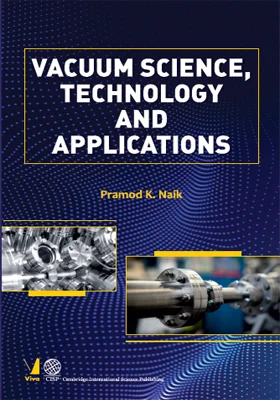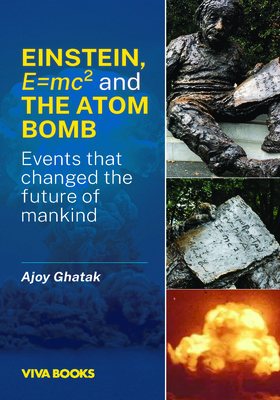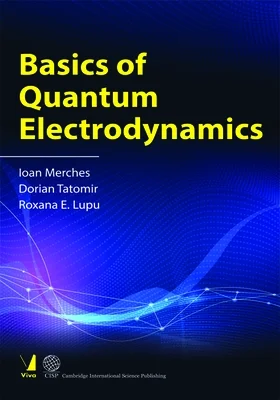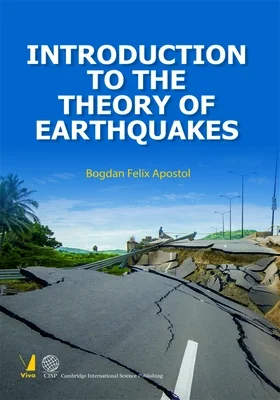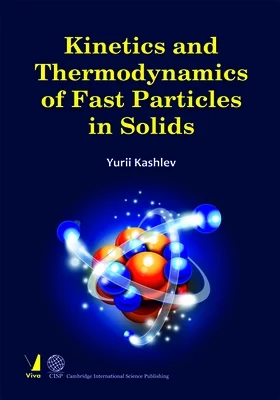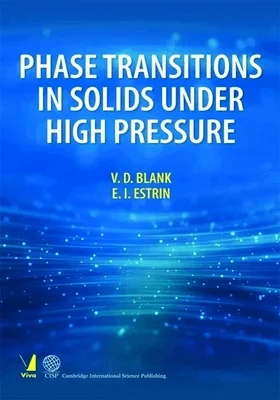Vacuum Science, Technology and Applications
Vacuum Science, Technology and Applications
₹1,615.50 ₹1,795.00 Save: ₹179.50 (10%)
Go to cart-
Out of Stock
ISBN: 9789392299247
Bind: Hardback
Year: 2022
Pages: 246
Size: 6 x 9 Inch
Publisher: Cambridge International Science Publishing
Published in India by: Viva Books
Exclusive Distributors: Viva Books
Sales Territory: India, Nepal, Bangladesh, Sri Lanka
Description:
Vacuum plays an important role in science and technology. The study of interaction of charged particles, neutrals and radiation with each other and with solid surfaces requires a vacuum environment for reliable investigations. Vacuum has contributed to major advancements made in nuclear science, space, metallurgy, electrical/electronic technology, chemical engineering, transportation, robotics and many other fields. This book is intended to assist students, scientists, technicians and engineers with understanding the basics of vacuum science and technology for application in their projects. The fundamental theories, concepts, devices, applications, and key inventions are discussed.
Target Audience:
This book is intended to assist students, scientists, technicians and engineers with understanding the basics of vacuum science and technology for application in their projects. Useful for physics graduates.
Contents:
Preface and Acknowledgements
Introduction
Author
CHAPTER 1. KINETIC THEORY OF GASES • Basic Concepts • Pressure • Equation of State • Gas Density • Avogadro’s Law • Molecular Motion and Energy • Molecular Impingement Rate • Mean Free Path • Heat Transfer • Heat Transfer by Radiation • Heat Transfer by Conduction at Low Pressure • Convection • Thermal Transpiration
CHAPTER 2. FLOW OF GAS AND CONDUCTANCE • Types of Gas Flow • Viscous Flow • Molecular Flow • Conductance • Conductance in Molecular Flow Region • Conductance in Viscous Flow Region • Basic Pumping Equation • Standard Leaks • Rise of Pressure in Sealed-Off Vacuum Device
CHAPTER 3. SURFACE PHENOMENA • Neutrals-Surface Interactions • Diffusion of Gases • Permeation • Physical and Chemical Adsorption • Monolayer • Sticking Probability • Adsorption Isotherms and Surface Area • Desorption • Determination of Activated Energy of Desorption • Photon and Ion induced Desorption • Thin Films Deposition on Surfaces • Molecular Beam Epitaxy • Surface Ionization • Interaction of Charged Particles, Radiation and Heat with Solid Surface • Ion-Surface Interactions • Secondary Electron Emission by Ion-Surface Interaction • Entrapment of Injected Ions • Sputtering • Ion Beam Implantation • Ion Beam Deposition/Ion Plating • Electron-Surface Interactions • Secondary Electron Emission by Electrons • Auger Electron Emission • X-Ray Emission • Interaction of High Energy Electrons with Surface • Photon-Surface Interactions • Photo-electric Emission • Electric Field-Surface Interaction • Field Emission • Thermionic Emission • Emission from Contact Surfaces in Vacuum Arcs • Evaporation-Sublimation-Vapor Pressure • Vacuum Evaporation
CHAPTER 4. INTERACTION OF NEUTRALS, CHARGED PARTICLES AND RADIATION WITH GASES IN VACUUM • Disassociation, Excitation and Ionization • Mean Free Path of Electrons and Ions • Ionization Potential and Ionization Efficiency/Cross Section • Positive Ion Impact Ionization • Ionization by Photons and Thermal Ionization • Deionization • Electrical Breakdown in Vacuum • Gas Breakdown • Glow Discharge • Vacuum Breakdown • Plasma
CHAPTER 5. MEASUREMENT OF PRESSURE • Mechanical Gauges • Manometers • McLeod Gauge • Diaphragm Gauges • Knudsen Gauge • Bourdon Gauge • Thermal Conductivity based Gauges • Ionization Gauges • Hot Cathode Ionization Gauges • Schulz and Phelps Gauge • Conventional Hot Cathode Ionization Gauge • Bayard-Alpert Gauge • Modulated Bayard-Alpert Gauge • Extractor Gauge • Magnetron Gauge • Helmer Gauge • Helmer Gauge-1800 Ion Deflection • Axial Symmetrical Transmission Gauge • Orbitron Gauge • Cold Cathode Ionization Gauges • Penning Gauge • Magnetron and Inverted Magnetron Gauges • Partial Pressure Gauges • Magnetic Sector Mass Spectrometer • Omegatron • Quadrupole Mass Analyzer • Time of Flight Mass Analyzer • Detectors • General Discussion on Residual Gas Analyzers
CHAPTER 6. VACUUM PUMPS • Positive Displacement Pumps • Water Ring Pump • Rotary Vane Pump and Rotary Piston Pump • Turbo-molecular Pump • Roots Pump • Diaphragm Pump • Screw, Scroll and Claw Pumps • Diffusion Pump • Vapor Booster Pump • Pumps using Conversion of Gas into Solid Phase • Getter Pumps • Bulk Getters • Flash and Evaporable Getters • Getter-Ion Pumps • Sputter-Ion Pump • Normal Diode Sputter-Ion Pump • Stabilized Diode Pumps • Slotted Cathode Pump • Post Cathode Pump • Differential Ion Pump • Triode Pump • Integrated Linear Pumps • Pressure Range and Operational Aspects • Cryogenic Pumps • Cryo-Condensation Pumps • Cryo-Sorption Pumps • Pumping by Cryo-Trapping • Types of Cryo-Pump
CHAPTER 7. SYSTEM DESIGN • Selection of Pumps • Pumpdown • Pumpdown Time • Symbolic Diagrams
CHAPTER 8. VACUUM MEASUREMENT METHODS • Pumping Speed Measurements • Calibration of Gauges
CHAPTER 9. VACUUM MATERIALS, HARDWARE, FABRICATION TECHNIQUES, CLEANING PROCESSES AND SURFACE TREATMENT • Couplings and Flanged Joints • Hoses and Bellows • Vacuum Valves and Traps • Mechanical Manipulators for Vacuum • Glass-to-Metal Seals • Ceramic-to-Metal Seals • Fabrication Techniques • Soldering and Brazing • Vacuum Brazing • Welding • Electron Beam Welding • Cleaning • Mechanical Cleaning • Chemical Cleaning • Electro-Chemical Cleaning • Ultrasonic Cleaning • Thermal Cleaning Processes • Commonly Used Chemicals • Clean Rooms
CHAPTER 10. LEAK DETECTION • Methods using Pressurization • Methods using Evacuation • Leak Detector Calibration
CHAPTER 11. EXTREME HIGH VACUUM • Factors governing Ultrahigh and Extreme High Vacuum • Pumps for XHV • Gauges for XHV • Reduction of Outgassing
CHAPTER 12. APPLICATIONS • General • Surface Analysis • Ion Scattering Spectroscopy • Secondary Ion Mass Spectrometry • Auger Electron Spectroscopy • Electron Spectroscopy for Chemical Analysis • Low Energy Electron Diffraction and Reflected High Energy • E Electron Diffraction • Electron Microscopy • Scanning Electron Microscope • Transmission Electron Microscope • Reflection Electron Microscope • Scanning Transmission Electron Microscope • Field Emission Microscope • Field Ion Microscope • Space Simulation • Gravitaiona Waves • Vacuum Furnaces • Particle Accelerators • Plasma Applications • Plasma Fusion Machines • Vacuum Plasma Spraying • Thin Films Applications • Vacuum Interrupters • Recent Advances
About the Author:
Pramod K. Naik has been actively involved in Vacuum Science & Technology since 1958. He obtained Ph.D. in Physics from the University of Bombay (now University of Mumbai). He investigated electrical oscillations in “Philips Ionization Gauge” and allied type of D.C. glow discharge with Dr. VT Chiplonkar at The Institute of Science, Mumbai. He joined the Atomic Energy Establishment, Trombay (now Bhabha Atomic Research Centre) at Mumbai in 1961. At BARC, he was engaged in development of high and ultrahigh vacuum components and systems. He was appointed as a member of the expert group formed for the Synchrotron Radiation Source. At BARC, he developed thermal desorption spectrometer and investigated entrapment of energetic inert gas ions near molybdenum solid surface. He has published many papers in reputed international journals. He worked with Dr. RG Herb at the University of Wisconsin, Madison, Wisconsin USA in the field of ultrahigh vacuum and developed the glass orbitron pump. He has also worked at the Westinghouse Electric Corporation (now Eaton Corporation) where he was engaged in absorption of vacuum interrupter technology. He worked as a manager at Crompton Greaves, Aurangabad. He has been associated with the Indian Vacuum Society and has organized a number of short-term courses in Vacuum Science & Technology. He received the Lifetime Achievement Award for his outstanding contributions in the field of Vacuum Science & Technology from the Indian Vacuum Society in the year 2003.
